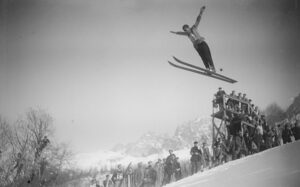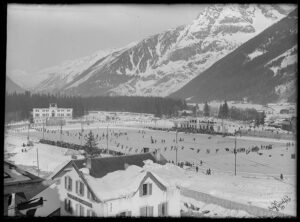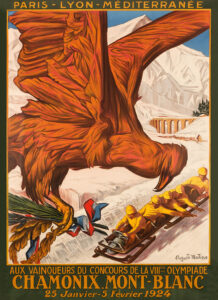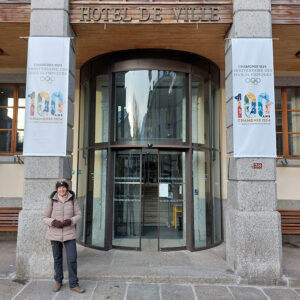
Buy Zolpidem Er 12.5 Mg PHOTO: © Archives municipales de Chamonix-Mont-Blanc Fonds Gay-Couttet
Ambien Online Iain Martin celebrates 100 years since Chamonix hosted the Olympics.
In the century since Chamonix hosted the first Winter Olympics, the depth of the Mer de Glace has shrunk by more than 100 metres. The change is so great that in February 2024, a new gondola was opened from the glacier back to Montenvers to save skiers who have taken on the famous Vallée Blanche off-piste run from having to tackle the 580 steps that now exist back to the top.
https://www.scarpellino.com/lb81z224bf3 Yet while the snow and ice of the surrounding mountains have seen marked changes since Chamonix first hosted the Winter Olympics in 1924, much of the town itself remains the same as when the first athletes walked those very streets.
Bernadette Tsuda is a passionate Chamoniarde, who loves taking visitors back to follow the steps of those first Olympians on her guided heritage tours. I met Bernadette outside the town hall, where she set the scene: “On the 25th of January 1924, the mayor, Jean Lavelle, welcomed 300 competitors from 17 countries as they started their parade towards the ice rink where the opening ceremony took place.”
As we walked past tourists eyeing expensive puffer jackets in Moncler, Bernadette pointed to the balcony just above the shop window: “One hundred years ago, guests of Hotel Le Metropole, as it was then, stood there, waving and cheering as the procession passed.”
And what a sight they would have seen, as the participants carried with them their equipment to indicate their area of sporting expertise.
https://www.wefairplay.org/2025/03/11/kggux4b70pu “The skaters carried their skates in their hands, the curlers had their brushes, the skiers had their skis,” said Bernadette. “Thanks to snow in the streets, even the bobsleigh teams dragged their sleds behind them.”
https://ballymenachamber.co.uk/?p=k7skk2k If taking part was enough for some, winning was still important. Some things don’t change: Norway topped the table, as they did at the most recent Games in Beijing.
Great Britain won four medals, including a gold in curling. Possibly more medals could have been won by Team GB had Alpine ski racing been included, rather than just Nordic skiing.
https://www.andrewlhicksjrfoundation.org/uncategorized/whhguno1 While still in its infancy, Briton Sir Arnold Lunn had already organised the first downhill race in Crans Montana in 1911. He would go on to organise the first timed slalom race in Murren in 1922, but ‘downhill’ racing wouldn’t be introduced to the Olympics until 1936.
https://www.fogliandpartners.com/ydk15io The delay was driven by politics. As a concession to the Scandinavian nations, who already held an annual ‘Northern Games’ winter event, much to the disappointment of Lunn, it had been agreed that Alpine racing would not be included.

https://www.wefairplay.org/2025/03/11/3h02xmyinp PHOTO: © Archives municipales de Chamonix-Mont-Blanc Fonds Gay-Couttet Stade Olympique
The truth is that in 1924, none of the competitors even realised they would be competing in the first Winter Olympics. The original idea had been to stage a winter celebration of sport in France as a companion piece to the Paris 1924 summer Olympics.
The games were originally simply “Sport d’Hiver Concours” (Winter Sports Competitions) to be held “on the occasion of the VIII Olympiad”, but Bernadette pointed out that, deliberately or not, it was destined to become an official Olympic event.
“Firstly, there was an opening ceremony, at which the athletes swore the Olympic oath. This is vital. Then as well, we see the Olympic flag flown at the three main venues: the ice rink, the bobsleigh and the ski jump.”
https://hazenfoundation.org/scdc59fzs These days, the use of the iconic Olympic rings symbol is restricted. Try and use this trademark without permission and the IOC will slap you down with legal action immediately. One hundred years ago, however, in simpler times with no official sponsors, evidently homemade Olympic flags were acceptable.
Ambien Buy Online Uk “We will never know if the organisers had the stamp of approval to use the rings,” Bernadette told me. “But we do know that the photos do not lie. And they show the Olympic emblem again and again in use at the event.”
She believes it was this ‘proof’ that allowed the IOC to retroactively designate the competition as the ‘first Winter Olympic Games’ in May 1926, putting in motion a four-year cycle that would include both the Summer and Winter Games.
Cheap Clonazepam Online It is a moot point whether winter sports will still be possible in Chamonix in another hundred years’ time.
Buy Zolpidem Online To Bernadette it is the principles of decency behind the Olympics that we will decide our future. “To me the Olympic spirit is everything,” she told me as we gazed up at Mont Blanc from the site of the opening ceremony, now a modern multi-purpose ice rink. “Keep your values simple; do your best; and uphold those fundamental Olympic ideals.”
https://www.tomolpack.com/2025/03/11/tf1y3fg0szn TRAVEL FACTS
- Iain travelled to and from Chamonix by train (from £194 return) and booked accommodation via Chamonix All Year
- Bernadette Tsuda offers guided heritage tours of Chamonix, bookable at the Tourist Office. The exhibition “ Chamonix 1924: The Invention of the Winter Olympic Games” continues at the Maison de la Mémoire et du Patrimoine until 15 March 2025.
-
Iain Martin is the presenter of The Ski Podcast. Catch up with over 220 episodes on their website, including Episode 200 which includes audio interviews with Bernadette Tsuda.
https://www.mdifitness.com/7tup7kht Categories: France, News
https://www.varesewedding.com/gy9xamyv Tags: Chamonix, Winter Olympics

